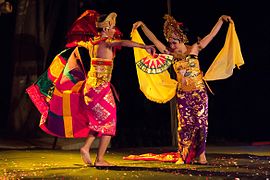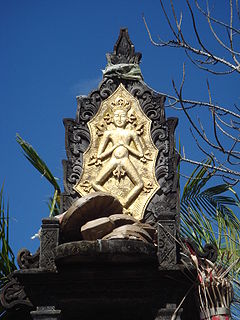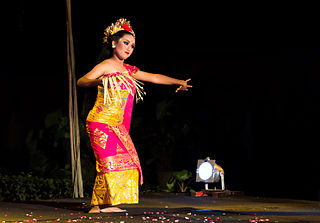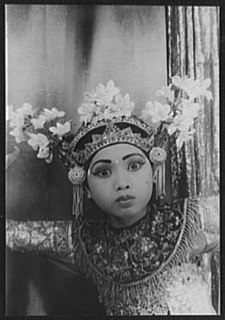 Sanata Dharma University's Balinese dance troupe "Sekar Jepun" performing an Oleg] | |
| Origin | Indonesia |
|---|---|
Oleg (also Oleg Tamulilingan or Oleg Tambulilingan), often identified as "the dance of the bumblebees", is a form of dance in Bali, Indonesia.
 Sanata Dharma University's Balinese dance troupe "Sekar Jepun" performing an Oleg] | |
| Origin | Indonesia |
|---|---|
Oleg (also Oleg Tamulilingan or Oleg Tambulilingan), often identified as "the dance of the bumblebees", is a form of dance in Bali, Indonesia.
Oleg is performed by a male and female dancer. It is intended to be evocative of a garden, in which bees are buzzing about, collecting nectar from the waiting flowers. The dancers represent a male and female bee, with the obsessively flirtatious male chasing the female from one flower to another. Though the female bee at first appears coquettish, she eventually accepts the male's advances. [1] [2] The movements of the female dancer are considered more complex than those of the male. [2]
The male and female dancers wear different costumes. The female is clad in a traditional fabric known as a prada, which is covered in gold paint, and has a long, sheer scarf to serve as her wings. On her head she wears a bouquet of flowers. The male dancer, meanwhile, wears similar fabric, which is arranged differently on his body so that it trails behind him. On his head he wears an udeng, a traditional Balinese hat, while in his hand he carries a fan. [3]
Owing to its bee and garden symbolism, which Kartika Suardana suggests is intended to convey the message that "both sexes naturally need each other", [1] oleg is often referred to as "the dance of the bumblebees". [4] It is one of numerous animal-themed dances in Bali, a genre which also includes the cendrawasih (bird-of-paradise) dance. [5]

Oleg was first choreographed by I Ketut Marya (better known in the West as I Mario) of Tabanan, Bali, in 1952 at the request of the music presenter John Coast, who intended to take a group of Balinese dancers on tour in Europe and the United States. Though I Mario, who had previously adapted the gamelan gong kebyar style of Balinese music into the kebyar duduk dance in 1925, considered himself too old to design a dance, he acquiesced after Coast continued to pressure him. [1] I Mario, working with Coast, the dancer I Wayan Sampih, and several other musicians, ultimately drew on images of ballet to create a fusion of Western and Balinese dance styles, [1] [6] while still promoting the dance as traditional. Coast's wife designed the original costumes for the dance, which was tested on Western audiences in Bali. [6] I Gusti Rasmin Raka and Sampih were the first dancers of oleg. [7] Young Balinese dancer Raka Rasmi was the first to perform the dance. [8]
Though initially controversial among traditionalists, as the female dancers had to raise their arms and expose their armpits to "fly", [7] oleg was absorbed into the canon of Balinese dance. Young children, many of whom had previously danced lenong, learned oleg. [4] [2] In his 2013 examination of the position of modern Balinese dance, Andrew McGraw considered oleg a now-classic kebyar dance. [6] In The Rough Guide to Bali and Lombok , Lesley Reader and Lucy Ridout described oleg as "one of most the vivacious, humorous, and engaging dances of the Balinese repertoire". [2]

Gamelan is the traditional ensemble music of the Javanese, Sundanese, and Balinese peoples of Indonesia, made up predominantly of percussive instruments. The most common instruments used are metallophones played by mallets and a set of hand-played drums called kendhang which register the beat. The kemanak and gangsa are commonly used gamelan instruments in Java. Other instruments include xylophones, bamboo flutes, a bowed instrument called a rebab, and even vocalists named sindhen.

Gamelan gong kebyar is a style or genre of Balinese gamelan music of Indonesia. Kebyar means "to flare up or burst open", and refers to the explosive changes in tempo and dynamics characteristic of the style. It is the most popular form of gamelan in Bali, and its best known musical export.

The Balinese people are an Austronesian ethnic group and nation native to the Indonesian island of Bali. The Balinese population of 4.2 million live mostly on the island of Bali, making up 89% of the island's population. There are also significant populations on the island of Lombok and in the easternmost regions of Java.

Baris is a family of traditional war dances in Bali, Indonesia, accompanied by gamelan, in which dancers depict the feelings of a young warrior prior to battle, glorify the manhood of the triumphant Balinese warrior, and display the sublimity of his commanding presence. Baris derives its name from the word bebarisan, which literally means "line" or "file formation", referring to the soldiers who served the ancient rajas of Bali.
A Balinese name is part of a system of identification used by the Balinese people and in the western parts of the neighboring island of Lombok, Indonesia. A Balinese name will have three parts: a title, a birth order name and a personal name. Balinese people do not use a family name.

Puputan is a Balinese term for a mass ritual suicide in preference to facing the humiliation of surrender. Notable puputans in the history of Bali occurred in 1906 and 1908, when the Balinese were being subjugated by the Dutch.

Acintya, also known as Sang Hyang Widhi Wasa and Sang Hyang Tunggal, is the Supreme God of Indonesian Hinduism, especially on the island of Bali. Acintya is equivalent to the metaphysical concept of Brahman of Indian Hinduism, and is the Supreme God in traditional wayang theatre. All gods, goddesses and existence are believed to be the manifestation of the Acintya in Balinese Hinduism.
I Wayan Gobiah was a Balinese teacher and writer. He is best known for Nemoe Karma, a 1931 novel which is considered the first Balinese-language novel.

The national costume of Indonesia is the national costume that represents the Republic of Indonesia. It is derived from Indonesian culture and Indonesian traditional textile traditions. Today the most widely recognized Indonesian national costumes include batik and kebaya, although originally those costumes mainly belong within the culture of Java and Bali, most prominently within Javanese, Sundanese and Balinese culture. Since Java has been the political and population center of Indonesia, folk costume from the island has become elevated into national status.

I Made Subandi is a gamelan composer and performer from Gianyar, Bali. Having studied with his father, drummer and gender wayang player I Made Dig, and at SMKI ('85-'88) and STSI ('89-'93), he teaches at the Indonesian Academy of Performing Arts in Bali. In 1999, during his residency with Gamelan Sekar Jaya, he composed a soundtrack for the 1933 silent film "Legong Dance of the Virgins" with American composer Richard Marriott, scored for Balinese gamelan, string quartet, trumpet and clarinet. He has collaborated with Dutch trio Boi Akih and American ensemble Club Foot Orchestra. He is well known for his use of experimentation. Tenzer describes Subandi as one of a few composers who, "have achieved a self-conscious and fundamental break with the tabuh kreasi form of the recent past."

The cendrawasih dance is a Balinese dance which is performed by two female dancers and illustrates the mating rituals of the bird of paradise.

Condong is a Balinese dance which is often performed as a preface to legong and accompanied by the semar pangulingan style of gamelan. The term also refers to a stock character, a quintessential representation of the maidservant, found in the condong dance, as well as the legong, gambuh, and arja dances.

Panyembrama is a secular Balinese dance form designed by I Wayan Berata and first performed in 1971. It includes movements from several sacral Balinese dances, which it was intended to replace for performance in front of tourists.

Kebyar duduk is a Balinese dance created by I Mario and first performed in 1925. Inspired by the development of the quick-paced gamelan gong kebyar, kebyar duduk is named for the seated and half-seated positions taken by the dancers. It does not convey a story, but is interpretative.

Paduraksa, also known as kori is a type of gateway covered with towering roof that can be found in the island of Java and Bali, Indonesia. This architectural feature is commonly found in buildings from the classical Hindu-Buddhist period of Indonesia. Paduraksa marks the threshold into the most sacred space within a religious compound, a cemetery, or a palace. In Balinese architecture, an elaborately decorated towering paduraksa is often built as the temple's most imposing structure.

Pura Taman Saraswati, officially Pura Taman Kemuda Saraswati, also known as the Ubud Water Palace, is a Balinese Hindu temple in Ubud, Bali, Indonesia. The pura is dedicated to the goddess Sarasvati. Pura Taman Saraswati is notable for its lotus pond.

Ni Gusti Ayu Raka Rasmi, also known as Raka Rasmi, was a Balinese dancer who introduced the stylized art of Balinese dance to the world. She was the youngest member of the Balinese dance troupe, the Bali Dancers, that was the first to perform in the United States in 1952.

Arja, also known as Balinese opera, is a popular form of Balinese theatre which combines elements of opera, dance, and drama. It was created in 1825 for the funeral of a Balinese prince. In the beginning it had an all-male cast; since the 20th century all performers have been women.
The Paruman Agung was the regional parliament of Bali from 1938 until 1950.
| Oleg (dance) |
|---|
|
| Burma |
| Cambodia |
| Indonesia |
|
| Laos |
| Malaysia |
| Philippines |
| Thailand |
| Vietnam |